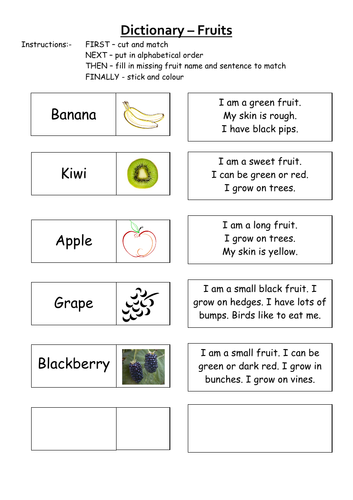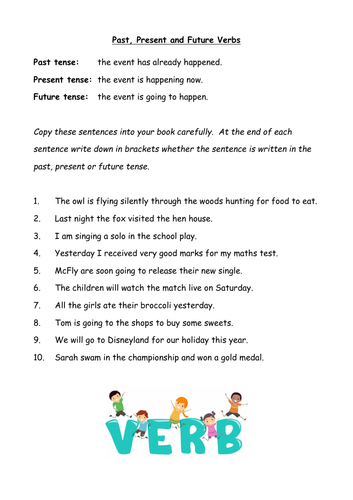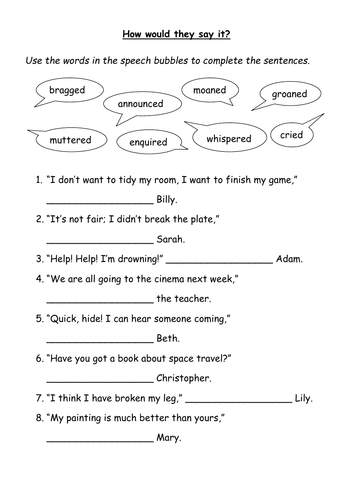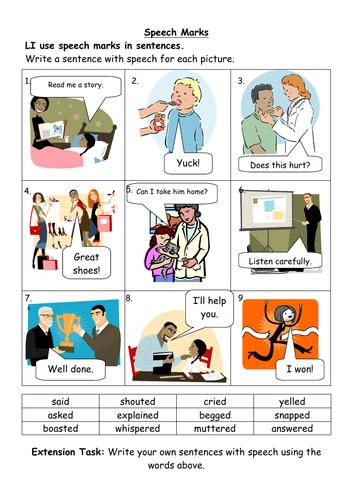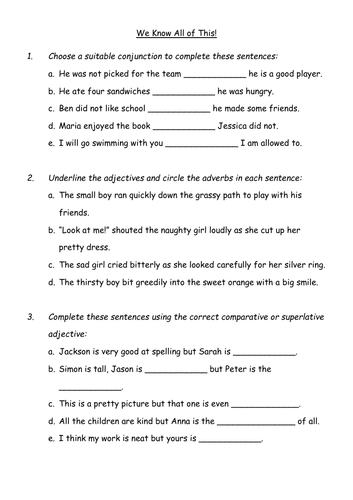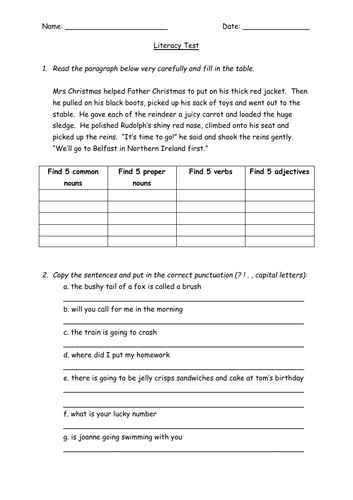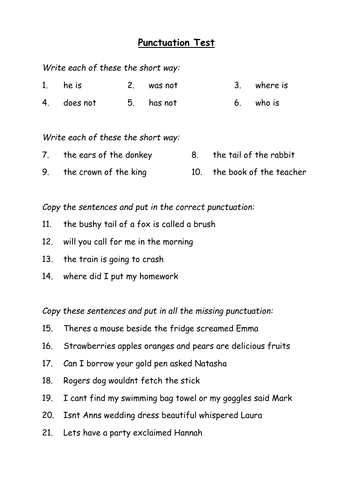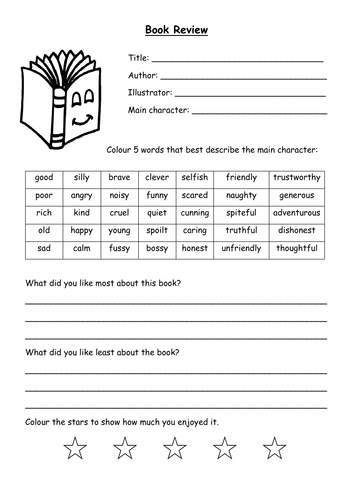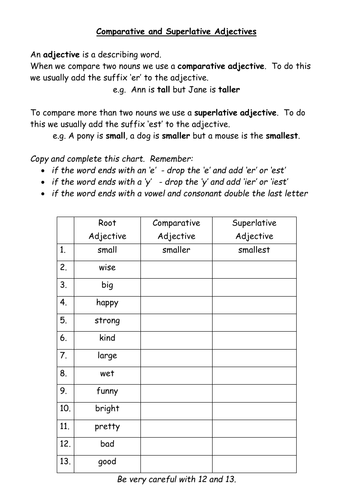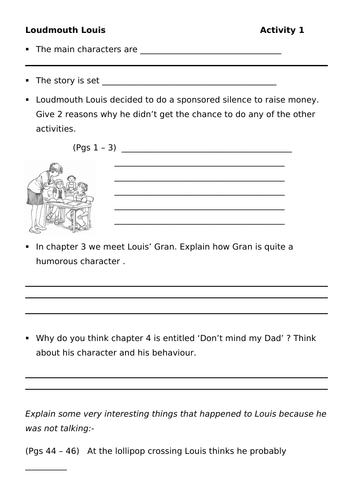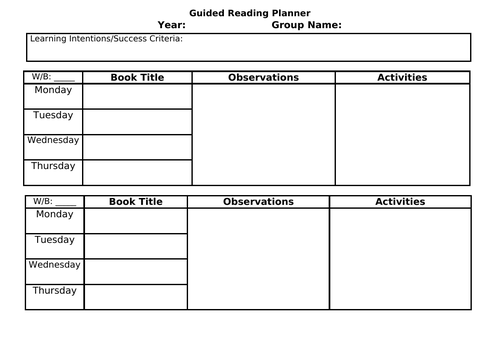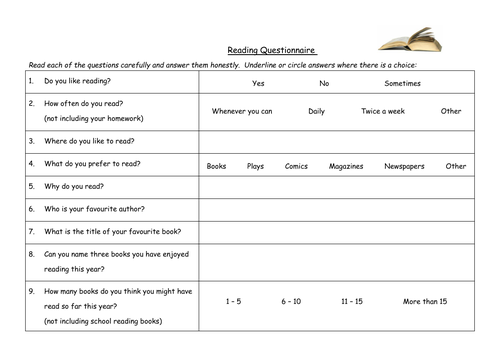89Uploads
13k+Views
1k+Downloads
Literacy for early years

KS1 Worksheet - Dictionary - Fruits (2 versions)
KS1 Worksheet - Dictionary - Fruits (2 versions)
Main activity - cut out the fruits and match them to the correct descriptions. Then put them in alphabetical order.
Version 1 - two fruits begin with the letter B so the 2nd letter will have to be used for ordering
Version 2 (easier) - all the fruits start with a different letter and the alphabet is provided as an aid.
Answers provided on the last page.

KS2 Worksheet - Verbs Tenses (2 worksheets)
KS2 Worksheet - Verbs Tenses - Past, Present and Future (2 worksheets)
Activity 1 - choose whether the sentences are written in the
past, present or future tense.
Activity 2 - choose four of the verbs and write three sentences for each
one, 1 in the past tense, 1 in the present tense and 1 in the future tense. Complete the table provided filling in the past and future tenses of the verbs given.
Answers provided on the last page.

KS2 Worksheet - Synonyms (2 versions)
KS2 Worksheet - Synonyms (2 versions)
Version 1:
Main activity - use the most appropriate synonym from the speech bubbles to complete the sentences.
Challenge - write a sentence for each of the synonyms given for the word ‘said’.
Version 2 (easier):
Main activity - use the most appropriate synonym from the speech bubbles to complete the sentences.
Answers provided on the last page.

KS2 Worksheet - Speech Marks (2 worksheets)
KS2 Worksheet - Speech Marks (2 worksheets)
Activity 1 - Write a sentence for each picture including the spoken words and correct punctuation.
Extension - Write sentences with speech using the words provided.
Activity 2 - Place speech marks and punctuation correctly in each sentence.
Extension - Write sentences with speech using the words provided.
Answers provided on the last page.

KS2 Worksheet - Correcting Spelling Mistakes (1 worksheet)
KS2 Worksheet - Correcting Spelling Mistakes (1 worksheet)
Activity 1 - correct 2 spellings mistakes in each sentence
Answers provided on the last page.

KS2 Worksheet - Literacy Test 3 (2 versions)
KS2 Worksheet - Literacy Test 3 (2 versions)
Version 1:
Section 1 - choose a suitable conjunction to complete each sentence
Section 2 - underline the adjectives and circle the adverbs in each sentence
Section 3 - complete the sentences using the correct comparative or superlative adjective
Section 4 - complete the sentences using the correct homphones (your/you’re, there/their/they’re and done/did)
Section 5 - copy the sentences and put in the correct capital letters and punctuation (? . , ! “” )
Version 2 (easier):
Section 1 - choose a suitable conjunction to complete each sentence (conjunctions given)
Section 2 - underline the adjectives in each sentence
Section 3 - complete the table using the correct comparative or superlative adjective
Section 4 - complete the sentences using the correct homphones (your/you’re and there/their/they’re)
Section 5 - copy the sentences and put in the correct capital letters and speech marks
Answers provided on the last page.

KS1 Worksheet - Literacy Test (2 versions)
KS1 Worksheet - Literacy Test (2 versions)
Version 1:
Section 1 - write sentences filling in missing capital letters and punctuation
Section 2 - jumbled sentences - order correctly
Section 3 - choose a/an for each sentence
Section 4 - choose is/are for each sentence
Section 5- choose has/have for each sentence
Section 6 - choose was/were for each sentence
Section 7 - choose the opposite word for the ones given
Section 8 - write a word that rhymes with the given words
Section 9 - put 5 words in alphabetical order
Section 10 - underline the 2 nouns in each sentence
Section 11 - underline the verb in each sentence
Section 12 - choose a suitable adjective to add to each sentence
Section 13 - changing words to plurals (adding s and es mixed)
Version 2 (easier):
Section 1 - write sentences filling in missing punctuation
Section 2 - write sentences filling in missing capital letters
Section 3 - choose a/an for each word
Section 4 - choose is/are for each sentence
Section 5- choose has/have for each sentence
Section 6 - choose the opposite word for the ones given
Section 7 - write a word that rhymes with the given words (3 letter words)
Section 8 - put 4 words in alphabetical order
Section 9 - underline any noun in each sentence
Section 10 - underline the verb in each sentence
Section 11 - fill in the missing word using a suitable adjective
Section 12 - changing words to plurals (adding s in 1 column and adding es in the other column)
Answers provided on the last page.

KS2 Worksheet - Literacy Test 4 (2 versions)
KS2 Worksheet - Literacy Test 4 (2 versions)
Version 1:
Section 1 - put 5 words in alphabetical order (using 1st and 2nd letters)
Section 2 - write a definition for the words: noun, verb and adjective
Section 3 - write the best collective noun for each phrase
Section 4 - choose 4 common nouns, proper nouns, verbs and adjectives from the passage given
Section 5 - copy the sentences and put in the correct capital letters and punctuation (? . , ! )
Version 2 (easier):
Section 1 - put 4 words in alphabetical order (using 1st letter)
Section 2 - match the definitions to the words: noun, verb and adjective
Section 3 - choose the best collective noun for each phrase for the words given
Section 4 - choose 4 nouns, verbs and adjectives from the passage given
Section 5 - copy the sentences and put in the correct capital letters and punctuation (? . )
Answers provided on the last page.

KS2 Worksheet - Literacy Test 1 (2 versions)
KS2 Worksheet - Literacy Test 1 (2 versions)
Version 1:
Section 1 - identify 5 common nouns, proper nouns, verbs and adjectives in the given passage
Section 2 - copy the sentences and put in the correct capital letters and punctuation (? ! . , )
Section 3 - copy the sentences and put in the missing speech marks and punctuation
Section 4 - choose their or there to complete the sentences
Section 5 - choose are, our or hour to complete the sentences
Version 2 (easier):
Section 1 - identify 4 nouns, verbs and adjectives in the given passage
Section 2 - copy the sentences and put in the correct capital letters and punctuation (? . )
Section 3 - copy the sentences and put in the missing speech marks and capital letters
Section 4 - choose their or there to complete the sentences
Section 5 - choose are, our or hour to complete the sentences
Answers provided on the last page.

KS2 Worksheet - Punctuation Test 2 (2 versions)
KS2 Worksheet - Punctuation Test 2 (2 versions)
Version 1:
Section A: write the contractions
Section B: use apostrophes for belonging to
Section C: write out sentences inserting all the missing punctuation (capital letters, full stops, exclamation marks and question marks)
Section D: write out sentences inserting all the missing punctuation (capital letters, full stops, exclamation marks, question marks and commas) and speech marks
Version 2 (easier):
Section A: write the contractions
Section B: use apostrophes for belonging to
Section C: write out sentences inserting all the missing punctuation (capital letters, full stops and question marks)
Section D: write out sentences inserting the missing speech marks
Answers provided on the last page.

KS1/KS2 Worksheet - Book Reviews (6 versions)
KS1/KS2 Worksheet - Book Reviews (6 versions)
Each book review begins with listing the title, author and illustrator.
Children are asked to describe the main character, setting and their most/least favourite part.

KS2 Worksheet - Comparative and Superlative Adjectives (2 versions)
KS2 Worksheet - Comparative and Superlative Adjectives (2 versions)
Version 1:
Activity - complete the table by filling in both the missing comparative and superlative adjectives for each word. Includes words good and bad where the word changes.
Version 2 (easier):
Activity - complete the table by filling in 1 missing comparative/superlative adjective for each word.
Answers provided on the last page.

KS1/KS2 - Reading Activities - Loudmouth Louis (3 worksheets)
KS1/KS2 - Reading Activity - Loudmouth Louis (3 worksheets)
Activity 1 worksheet
Activity 2 worksheet
Activity 3 worksheet

Blank Guided Reading Planner
Blank Guided Reading Planner
Fill in date, group name, book title, learning intentions, observations and activites.

KS1/KS2 Worksheet - Spelling Journal (Tricky Words)
KS1/KS2 Worksheet - Spelling Journal (Tricky Words)
A record sheet for recording those tricky spelling words and ideas of how to remember it.
e.g. “heard” - letter h - you use your “ear” to hear sound - letter d

KS2 Worksheet - Literacy Test 2 (2 versions)
KS2 Worksheet - Literacy Test 2 (2 versions)
Version 1:
Section 1 - copy the sentences and put in the correct capital letters and punctuation (? ! . , “” )
Section 2 - underline the nouns in the sentences
Section 3 - underline the verbs in the sentences
Section 4 - underline the adjectives in the sentences
Section 5 - underline the adverbs in the sentences
Section 6 - add apostophes to contractions and to show belonging to
Section 7 - change given words to plurals (adding s, es, remove f and add ves, remove y and add ies, words stay the same and spelling changes completely)
Section 8 - put 5 words in alphabetical order (using 1st and 2nd letters)
Version 2 (easier):
Section 1 - copy the sentences and put in the correct capital letters and punctuation (? . )
Section 2 - underline the nouns in the sentences
Section 3 - underline the verb in the sentences
Section 4 - underline the adjectives in the sentences
Section 5 - underline the adverbs in the sentences
Section 6 - add apostophes to show belonging to
Section 7 - change given words to plurals (adding s and es)
Section 8 - put 5 words in alphabetical order (using 1st letter)
Answers provided on the last page.

KS1/KS2 - Reading Questionnaire
KS1/KS2 - Reading Questionnaire
Activity - complete questionnaire about reading including how often they read, where they read, the genres/authors they prefer, why they read, etc.
Easy to complete by circling options and writing sentences.

Learning Facts - Literacy (4 sets)
Learning Facts - Literacy (4 sets)
Fact cards that can be printed or uploaded for online learning.
Set 1: facts about nouns, verbs, adjectives and adverbs
Set 2: facts about homophones
Set 3: facts about tenses and singular/plural
Set 4: facts about apostrophes and speech marks

